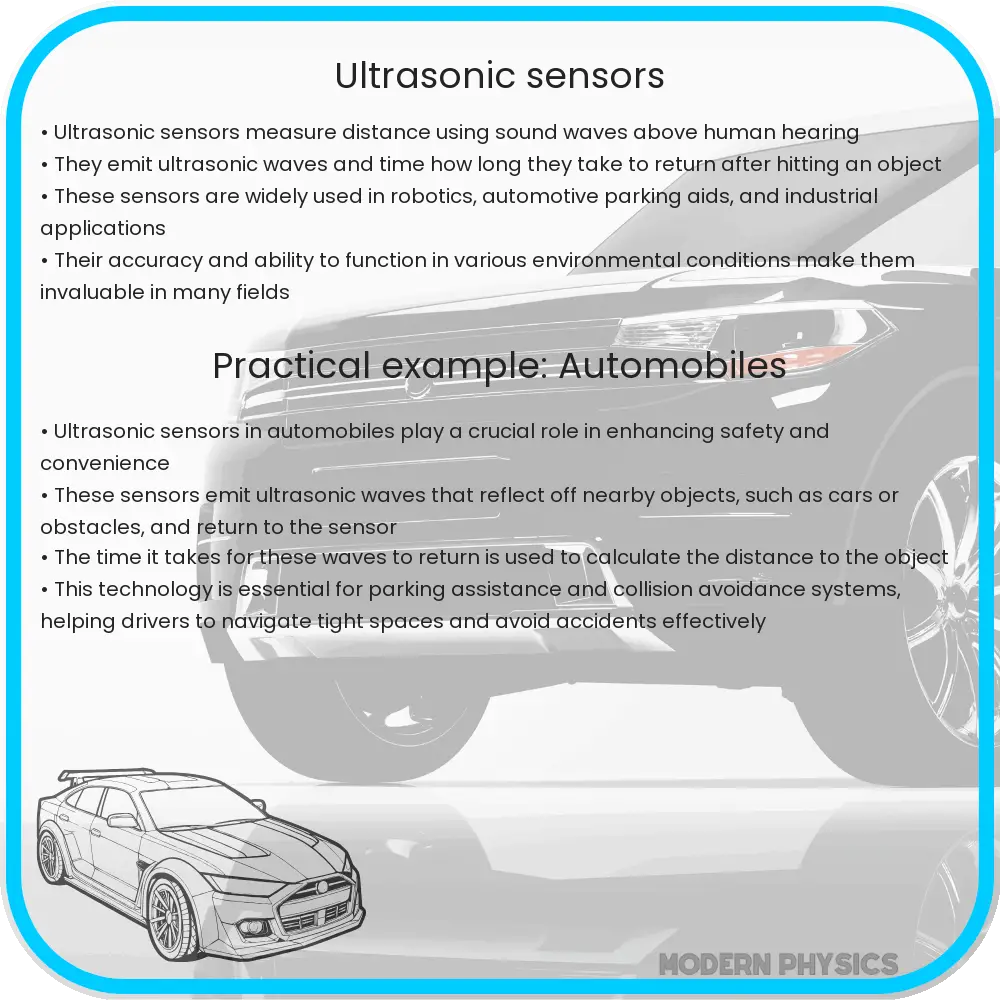Learn about ultrasonic sensors, devices using high-frequency sound waves to detect objects and measure distances in various industries.

Introduction to Ultrasonic Sensors
Ultrasonic sensors are a cornerstone in the field of sensor technology. These devices utilize sound waves at frequencies higher than the upper audible limit of human hearing to detect objects and measure distances. This technology finds applications in various fields such as robotics, automotive systems, manufacturing, and even healthcare.
How Ultrasonic Sensors Work
At the core of ultrasonic sensor technology is the use of high-frequency sound waves—typically in the range of 20 kHz to several gigahertz. The operation of an ultrasonic sensor can be explained in three main steps:
- Emission: The sensor emits an ultrasonic sound wave at a specific frequency, which travels through the air.
- Reflection: Once the sound wave encounters an object, it bounces back to the sensor as an echo.
- Detection: The sensor receives the echo and calculates the time interval between sending the wave and receiving the echo.
The distance to the object is then calculated using the speed of sound in air and the time of travel of the sound waves. The formula used is:
D = 0.5 * T * C
Where:
- D is the distance to the object,
- T is the time interval from emission to reception,
- C is the speed of sound in the medium (approximately 343 meters per second in air at 20°C).
Applications of Ultrasonic Sensors
Ultrasonic sensors are highly valued for their versatility and accuracy. Here are some of the typical uses:
- Robotics: Robots employ ultrasonic sensors to navigate by detecting obstacles and mapping their environment.
- Automotive: These sensors are critical components in autonomous cars for collision avoidance and in parking assist systems to gauge distances between vehicles and obstacles.
- Industrial: In manufacturing, ultrasonic sensors are used for controlling the position of parts on production lines and ensuring that equipment operates safely and efficiently.
- Medical: These sensors help in various diagnostic and therapeutic applications, notably in imaging such as ultrasounds used in prenatal diagnostics.
The precision and non-intrusive nature of ultrasonic sensors make them an invaluable tool in many high-tech and industrial setups. By using sound waves, these sensors can perform in conditions where other methods might fail, such as in low visibility or where contact with the object is impractical.
Advantages and Limitations of Ultrasonic Sensors
While ultrasonic sensors are widely used due to their reliability and accuracy, they come with both strengths and shortcomings that are critical to understand.
Advantages
- Non-contact Measurement: Ultrasonic sensors measure distances without needing to touch the objects, making them ideal for applications requiring sterile conditions or where the object is sensitive.
- Versatility: They can be used in a variety of environments and materials, including opaque or transparent, liquid or solid.
- Cost-effective: Compared to some other sensing technologies, ultrasonic sensors are relatively inexpensive and offer good value for money in many applications.
- Easy to use: These sensors are generally simple to integrate and require minimal maintenance, further reducing overall operational costs.
Limitations
- Sensitivity to Environmental Factors: Factors such as temperature, humidity, and air turbulence can affect the accuracy of ultrasonic sensors.
- Angle of Incidence: The sensor must be properly aligned with the object for accurate measurement, as oblique angles can distort the returning sound waves.
- Range Limitations: While effective for short to medium distances, their accuracy diminishes over long ranges or with very small objects.
Future Trends in Ultrasonic Sensor Technology
Advancements in ultrasonic sensor technology continue to broaden their potential applications. Researchers are constantly working on enhancing the precision, range, and durability of these sensors. Future developments may include:
- Integration with AI: Incorporating artificial intelligence to interpret sensor data more effectively, potentially enhancing decision-making processes in autonomous vehicles and robotics.
- Improved Materials: Using advanced materials to build more robust sensors that perform better under extreme environmental conditions.
- Miniaturization: Developing smaller sensors which can be integrated into a wider array of products, including wearable technology.
As these innovations unfold, ultrasonic sensors are set to become an even more integral part of our technological landscape.
Conclusion
Ultrasonic sensors play a significant role in modern technology with their ability to deliver precise, reliable, and non-contact measurements. From ensuring the safety in cars to facilitating complex processes in industrial setups and aiding in medical diagnostics, these sensors showcase a remarkable range of utility. Despite certain limitations, their advantages and the continuous improvements in their technology hint at an even broader scope of applications in the future. Understanding both the capabilities and restrictions of ultrasonic sensors is essential for optimizing their use in various professional fields. This know-how will not only help in choosing the right sensor for the right application but also in harnessing their full potential as we move forward into an increasingly automated world.
